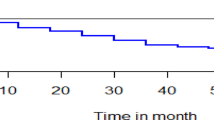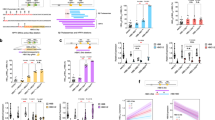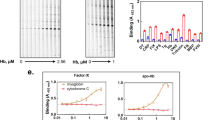Abstract
We have expressed human αand β-globin cDNA clones from separate, synthetic galactose-regulated hybrid promoters contained on a single plasmid in Saccharomy-ces cerevisiae. Co-expression of the α and β-globin chains in S. cerevisiae results in the assembly of these proteins into soluble tetrameric hemoglobin that accumulates to 3–5 percent of the total cell protein. Endogenously produced heme is incorporated into the tetramer and the protein produced is functionally and structurally indistinguishable from human Ao hemoglobin. This expression system has been used to produce both wild type hemoglobin and a low O2-affinity hemoglobin mutant that has oxygen binding and dissociation characteristics similar to human whole blood. The yeast expression system we describe may be suitable for the production of a recombinant hemoglobin based blood substitute as well as for detailed structure-activity studies of human hemoglobin.
This is a preview of subscription content, access via your institution
Access options
Subscribe to this journal
Receive 12 print issues and online access
$259.00 per year
only $21.58 per issue
Buy this article
- Purchase on SpringerLink
- Instant access to full article PDF
Prices may be subject to local taxes which are calculated during checkout
Similar content being viewed by others
References
Benesch, R. and Benesch, R.E. 1967. The effect of organic phosphates from the human erythrocyte on the allosteric properties of hemoglobin. Biochem. Biophys. Res. Com. 26: 162–167.
Bleeker, W.K., Plas, van der, J., Feitsma, R.I.J., Agterberg, J., Rigter, G., deVries-van Rossen, A., Panwels, E.K.J. and Bekker, J.C. 1989. In vivo distribution and elimination of hemoglobin modified by intramolecular cross-linking with 2-nor-2-formyl pyridoxal 5′-phosphate. J. Lab. Clin. Med. 113: 151–161.
Lee, R., Atsumi, N., Jacobs, E., Austen, G.W. and Vlahalres, G.J. 1989. Ultrapure, stroma free, polymerized bovine hemoglobin solution: Evaluation of renal toxicity. J. Surg. Res. 47: 407–411.
Snyder, S., Welty, E.U., Walder, R., Williams, L.A. and Walder, J. 1987. HbXL99a: A hemoglobin derivative that is cross-linked between the α subunits is useful as a blood substitute. Proc. Nat. Acad. Sci. USA 84: 7280–7284.
Bucci, E., Razynska, A., Urbaitis, B. and Fronticelli, C. 1989. Pseudo crosslink of human hemoglobin with mono-(3,5-dibromosalicyl) fuma-rate. J. Biol. Chem. 264: 6191–6195.
Nagai, K. and Thogersen, H.C. 1987. Synthesis and sequence-specific proteolysis of hybrid proteins produced in Escherichia coli. Methods in Enzymology 153: 461–581.
Hoffman, S.J., Looker, D.L., Roehrich, J.M., Cozart, P.E., Durfee, S.L., Tedesco, J.L. and Stetler, G.L. 1990. Expression of fully functional tetrameric hemoglobin in Escherichia coli. Proc. Nat. Acad. Sci. USA. In press.
Perutz, M.F., Kilmartin, J.V., Nishikura, K., Fogg, J.H., Butler, P.G. and Rollema, H.S. 1980. Identification of residues contributing to the Bohr effect of human hemoglobin. J. Mol. Biol. 138: 649–670.
Arnone, A. 1972. X-ray diffraction study of binding of 2,3-diphos-phoglycerate to human deoxyhemoglobin. Nature 237: 146–149.
Benesch, R., Benesch, R.E., Renthal, R.D. and Maeda, N. 1972. Affinity labeling of the polyphosphate binding site of hemoglobin. Biochemistry 11: 3576–3582.
Holland, J.P. and Holland, M.J. 1979. The primary structure of a glyceraldehyde-3-phosphate dehydrogenase gene from Saccharomyces cerevisiae. J. Biol. Chem. 254: 9839–9845.
Holland, J.P. and Holland, M.J. 1980. Structural comparison of two nontandemly repeated yeast glyceraldehyde-3-phosphate dehydrogenase genes. J. Biol. Chem. 255: 2596–2605.
Johnston, M. and Davis, R.W. 1984. Sequences that regulate the divergent GAL1-GAL 10 promoter in Saccharomyces cerevisiae. Mol. Cell. Biol. 4: 1440–1448.
Guarente, L., Yocum, R. and Gifford, P. 1982. A GAL10-CYC1 hybrid yeast promoter identifies the GAL4 regulatory region as an upstream site. Proc. Nat. Acad. Sci. USA 79: 7410–7414.
Moo-Penn, W., Wolff, J., Simon, G., Vacek, M., Jue, D. and Johnson, M. 1978. Hemoglobin presbyterian: β108(G10) asparagines→lysine. A hemoglobin variant with low oxygen affinity. FEBS Lett 92: 53–57.
Arfin, S.M. and Bradshaw, R.A. 1988. Cotranslational processing and protein turnover in eukaryotic cells. Biochem. 27: 7979–7984.
Huang, S., Elliot, R.C., Liu, P.S., Koduri, R.K., Weickmann, J.L., Lee, J.H., Blair, L.C., Ghosh, P., Bradshaw, R.A., Bryan, K.M., Einarson, B., Kendall, R.L., Kolacy, K.H. and Saito, K. 1987. Specificity of cotranslational amino terminal processing of proteins in yeast. Biochem. 26: 8242–8246.
Tsunasawa, S., Stewart, J.W. and Sherman, F. 1985. Amino terminal processing of mutant forms of yeast iso-1-cytochrome C. The specificities of methionine amino peptidase and acetyltranslerase. J. Biol. Chem. 260: 5382–5391.
Bachmair, A., Finley, D. and Varshavsky, A. 1986. In vivo half-life of a protein is a function of its ammo-terminal residue. 1986. Science 234: 179–186.
Mattoon, J.R., Lancashire, W.E., Sanders, H.K., Carvajal, E., Mala-mud, D.R., Braz, R.C. and Panel, D. 1979. Oxygen and catabolite regulation of hemoprotein biosynthesis in yeast, p. 421–435. In: Biochemical and Clinical Aspects of Oxygen. W. S. Caughey (Ed.). Academic Press, Inc., NY.
Keng, T. and Guarente, L. 1987. Constitutive expression of the yeast HEM1 gene is actually a composite of activation and repression. Proc. Nat. Acad. Sci. USA 84: 9113–9117.
Tueblood, C.E., Wright, R.M. and Poynton, R.O. 1988. Differential regulation of the two genes encoding Saccharomyces cerevisiae cytochrome C oxidase subunit V by heme and the HAP2 and REO1 genes. Mol. Cell. Biol. 8: 4537–4540.
Lowry, C.V. and Zitomer, R.S. 1988. ROX1 encodes a heme-induced repression factor regulating ANB1 and CYC7 of Saccharomyces cerevisiae. Mol. Cell. Biol. 8: 4651–4658.
Bunn, H.F. and Forget, B.G. 1986. Hemoglobin: Molecular Genetic and Clinical Aspects. W. B. Saunders Co., Philadelphia, PA.
Valenzuela, P., Medina, A., Rutter, W.J., Ammerer, G. and Hall, B.D. 1982. Synthesis and assembly of hepatitis B virus surface antigen particles in yeast. Nature 298: 347–350.
Wood, C.R., Boss, M.A., Kenten, J.H., Calvert, J.E., Roberts, N.A. and Emtage, J.S. 1985. The synthesis and in vivo assembly of functional antibodies in yeast. Nature 314: 446–449.
Theriault, N.Y., Carter, J.B. and Palaski, S.P. 1988. Optimization of Hgation reaction conditions in gene synthesis. Bio Techniques 6: 470–473.
Stetler, G.L., Forsyth, C., Gleason, T., Wilson, J. and Thompson, R.C. 1989. Secretion of active, full- and half-length human secretory leukocyte protease inhibitor by Saccharomyces cerevisiae. Bio/Technology 7: 55–60.
Vandergriff, K.D., Medina, F., Marini, M.A. and Winslow, R.W. 1989. Equilibrium oxygen binding to human hemoglobin cross-linked between the α chains by bis (3,5-dibromosalicyl) fumarate. J. Biol. Chem. 624: 17824–17833.
Hewick, R.M., Hunkapiller, N.W., Hood, L.E. and Dreyer, W.J. 1981. A gas liquid solid phase peptide and protein sequenator. J. Biol. Chem. 256: 7990–7997.
Riggs, A. 1981. Preparation of blood hemoglobins of vertebrates. Methods in Enzymology 76: 5–29.
Laemmli, U.K. 1970. Cleavage of structural proteins during assembly of the head of the bacteriophage T4. Nature 227: 680–685.
Davis, R.W., Botstein, D. and Roth, J.R. 1980. Advanced Bacterial Genetics: A Manual for Genetic Engineering. Cold Spring Harbor Laboratory, N.Y.
Sherman, F., Fink, G. and Lawrence, C.W. 1979. Methods in Yeast Genetics: A Laboratory Manual. Cold Spring Harbor Laboratory, N.Y.
Ito, H., Fukuda, Y., Murata, K. and Kimura, A. 1983. Transformation of intact yeast cells treated with alkali cations. J. Bacteriol. 153: 163–168.
Author information
Authors and Affiliations
Rights and permissions
About this article
Cite this article
Wagenbach, M., O'Rourke, K., Vitez, L. et al. Synthesis of Wild Type and Mutant Human Hemoglobins in Saccharomyces cerevisiae. Nat Biotechnol 9, 57–61 (1991). https://doi.org/10.1038/nbt0191-57
Received:
Accepted:
Issue date:
DOI: https://doi.org/10.1038/nbt0191-57



